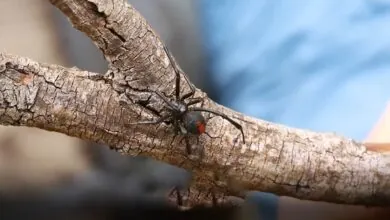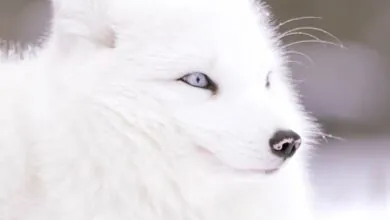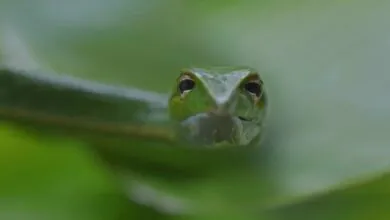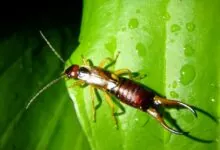From Dusk till Dawn: A Day in the Life of a Tawny Owl Bird
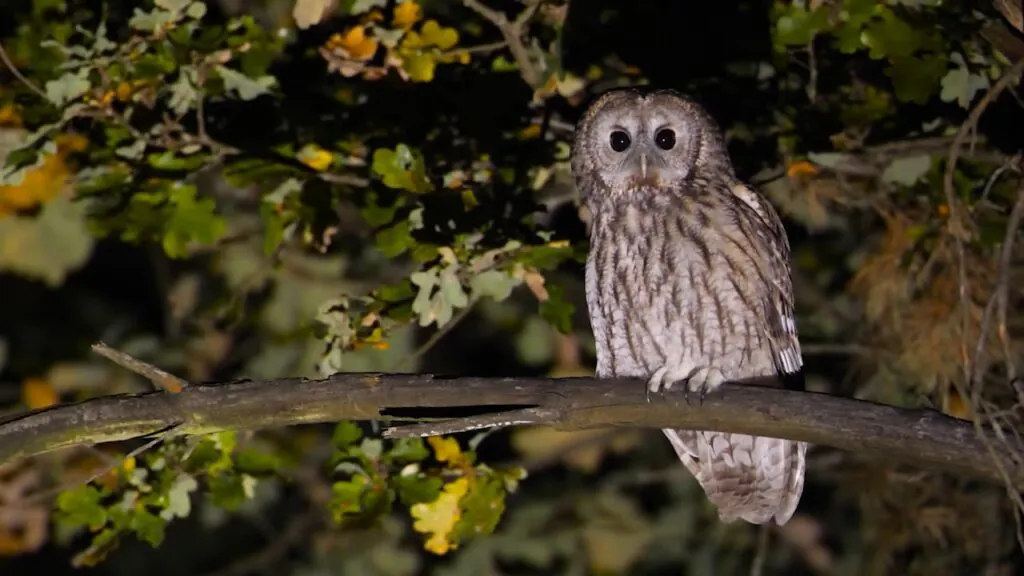
Just close your eyes and step into the hushed symphony of the twilight forest. Tune in for a haunting call – a deep, melodic hoot that pierces the stillness – that’s the tawny owl bird. In many cultures, it’s an emblem of wisdom and mystery. Thriving in woodlands across Europe and Asia, this predator is far more than just a pretty face. Let’s unfold its secrets, dissecting its fascinating features and hunting prowess.
| Kingdom | Phylum | Class | Order | Family | Genus | Scientific Name |
| Animalia | Chordata | Aves | Strigiformes | Strigidae | Strix | Strix aluco |
Origin and Evolution
Evolutionary History
In conjunction with the tawny owl evolution, fossil evidence posits their roots branched off from other Strigidae owls around 40 million years back, possibly in Eurasia. Key evolutionary events turned the tawny owl into the formidable predator we’re aware of today:
Glacial Cycles: Over the span of Pleistocene ice ages, fluctuating temperatures and shifting landscapes fragmented owl populations. The very isolations feasibly drove the diversification of subspecies, such as the Himalayan Tawny Owl.
Habitat Specialization: As forests receded and grasslands stretched, owls adapted their hunting strategies and priorities. This possibly honed their remarkable hearing and silent flight.
Genetic Composition and Diversity
The tawny owl genome – sequenced in 2015 – unfolded genes coupled with exceptional vision, keen hearing and efficient nocturnal metabolism. Researches exhibit distinct genetic clusters in Europe and Asia. For instance, European tawny owls tend to be smaller and lighter than their Asian counterparts.
Environmental Adaptations
With respect to the tawny owl adaptations, it’s a master of camouflage. This crypsis in conjunction with their silent flight enabled by feathery wing fringes let them have an undeniable edge in hunting small mammals and birds.
The tawny owl hearing, assisted by asymmetrical ear openings, determine prey with pinpoint accuracy even in complete darkness.
Over and above its physical adaptations, the tawny owl behavior is remarkably flexible. They instantly utilize abandoned woodpecker holes for nesting and alter their hunting strategies to prey abundance.
Distribution and Population
Geographic Range
In terms of the tawny owl distribution, it spans temperate woodlands across Europe and Asia. From British Isles in the west, their empire stretches through mainland Europe, touching eastward across Russia and into the Himalayas. In the annals of time, the tawny owl bird reign stretched even further, including parts of North Africa and the Middle East.
Population Dynamics
Speaking of the tawny owl population, it’s robust, with approximates ranging from 970,000 to 2 million individuals in Europe alone. On a global level, their numbers likely reach into the millions. Their population trends vary geographically. Some European populations have encountered slight downturns, due to habitat fragmentation and road mortality.
Geography
| Continents | Europe, Asia, and Africa (northwest) |
| Countries | Found in over 40 countries |
| Bio-geographical Realms | Palearctic and Indomalayan |
| Biome | Primarily found in temperate woodlands |
| Climate Zones | Mild oceanic, Continental, Subtropical |
Types of Tawny Owl
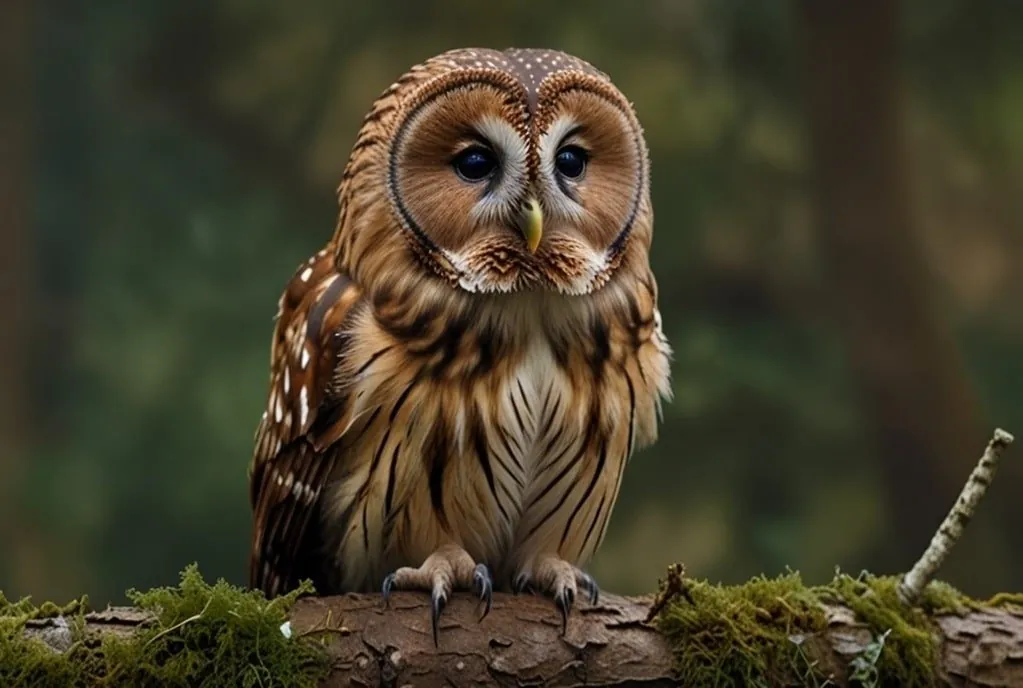
The Eurasian tawny owl, scientifically recognized as Strix aluco, is a widespread and adaptable bird of prey, having a plethora of subspecies across its stretched range.
The nominate subspecies grace woddlands across Europe and western Asia, painted in rufous brown and greyish brown.
These owls are larger and stockier than their western counterparts, residing in Eastern Europe and Siberia.
This type of owl carves a niche in the mountainous regions of Iran and Iraq and is known for its hybridization with the Common Tawny Owl.
The Siberian night owl is found in the vast taiga forests of western Siberia and central Russia and are among the largest Eurasian tawny owls.
These majestic creatures venture into southern Asia, finding their home in Pakistan and India.
Found in the arid landscapes of Turkmenistan, this owl sports a pale, desert-toned plumage.
Habitat
Habitat Preferences
Concerning the tawny owl habitat, they prefer temperate woodlands, expressly mature deciduous and mixed forests but also adaptable to open woodlands, parks and some urban green spaces with mature trees. Beyond these tawny owl ecosystems, they can inhabit edges of woodlands, valleys, stream edges, steep slopes and ravines.
Habitat Utilization Patterns
During breeding season, the tawny owls are relatively sedentary, guarding territory and hunting close by. Nomadic movements in winter are also observed to search for prey. The tawny owl is chiefly nocturnal, hunting over the span of the night with peak activity at dusk and dawn.
5 Tawny Owl Facts
Appearance
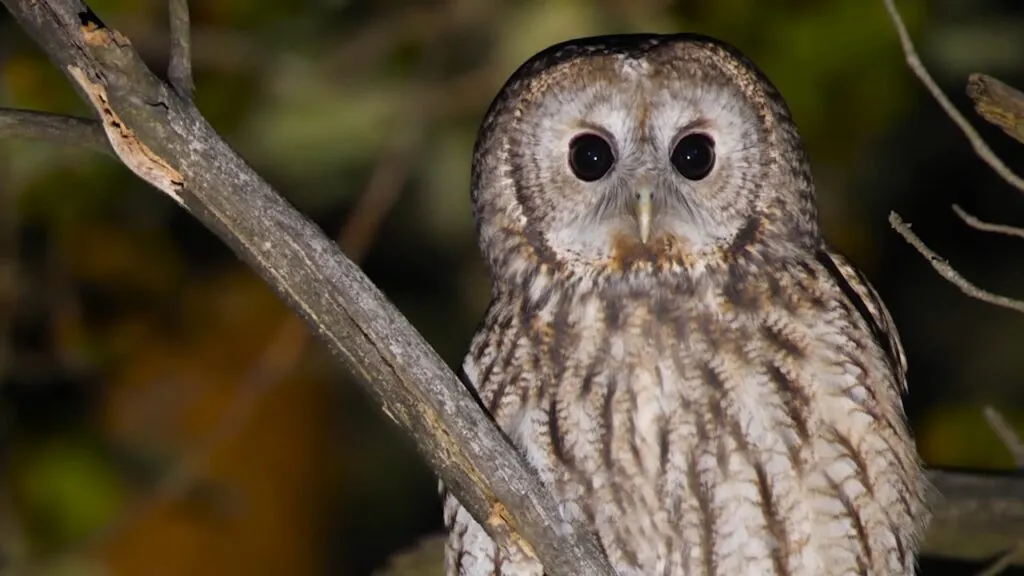
The tawny owl’s appearance is a makeup of both regal elegance and silent stealth. Let’s dig deep!
Physical Characteristics
Size and Shape: Concerning the tawny owl’s size, they measure 37 to 46 cm (15-18 in) in length, having a robust build with a rounded head and powerful hooked beak. The tawny owl’s wings reach up to 105 cm (41 in) in span.
Color: In terms of the tawny owl’s color, the upperparts normally sport a symphony of brown and grays, oftentimes tinged with rufous or tawny hues.
Markings: What adorns their underparts is the dark streaks and barring. Their facial disc framed by a dusky ruff exhibits two large, mesmerizing eyes that pierce the darkness with unparalleled vision. Dissimilar to some owl species, tawny owls lack ear tufts.
Anatomy
| Color(s) | Rufous brown, buff, and white with dark streaks and barring |
| Tongue | Short, notched, and non-protrusible |
| Claws | Sharp and curved |
| Mouth | Wide gape with hooked beak |
| Jaw | Powerful and hooked |
| Teeth | Small and serrated |
| Nose | Facial discs with keen sense of smell |
| Feet | Feathered toes with reversible outer toe |
| Skeleton | Lightweight and adapted for silent flight |
Reproduction and Life Cycles
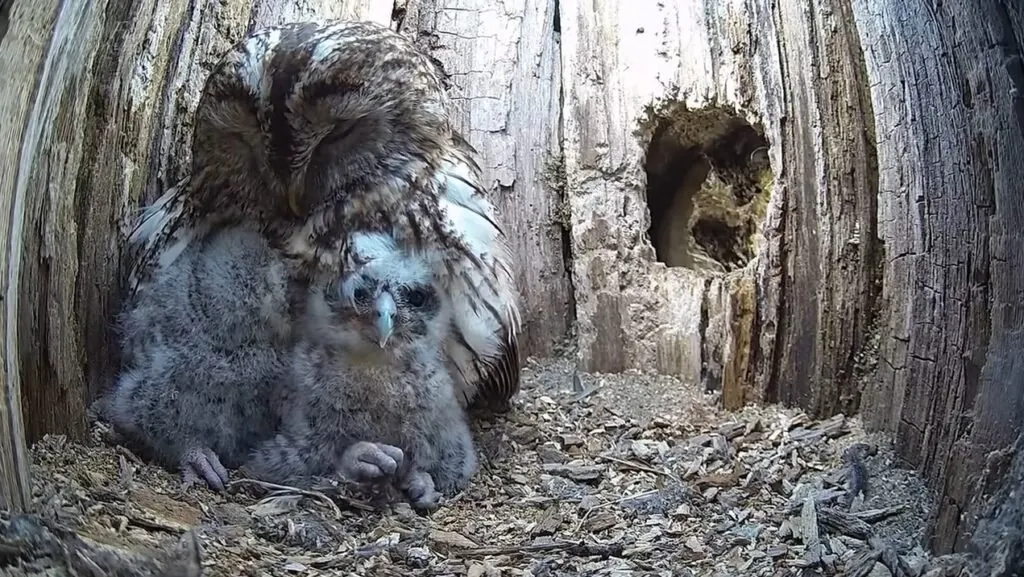
Mating System
With respect to the tawny owl mating system, they are predominantly monogamous, constructing strong pair bonds that often last a lifetime.
Reproductive Biology
Concerning the tawny owl breeding season, it takes place from February to April, with asynchronous hatching of eggs laid at intervals. Both parents share responsibilities. Their clutch size is typically betwixt 2 and 5.
Life Cycle Stages
The tawny owl life cycle kicks off with a hatch covered in white down, completely dependent on parents. It little by little develops adult plumage and fight skills, venturing out of the next at 5 to 6 weeks. These juveniles reach independent living after 8 to 10 weeks. Speaking of the tawny owl lifespan, they can live up to 20 years in the wild.
Mating Habits
| Mating Behavior Monogamous pairs, courtship with hooting & food gifts | |
| Reproduction Season Late Winter/Early Spring (February-March) | |
| Litter Size 2-5 eggs (usually) | |
| Independent Age 50-60 days for fledging |
Diet and Lifestyle
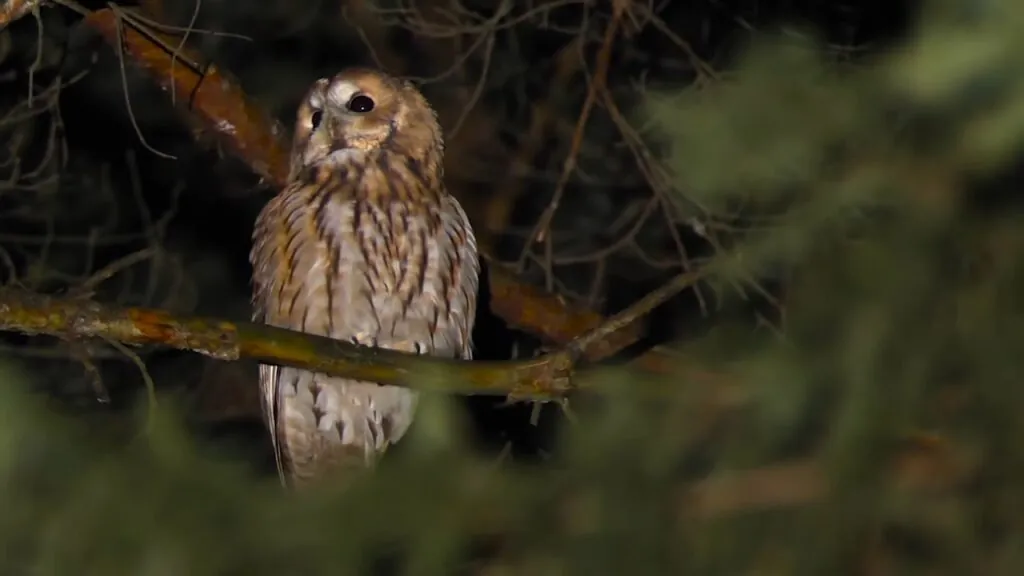
As for as the tawny owl’s diet is concerned, it’s not a picky eater, but they’re a decisive predator. Let’s dig deep into their lifestyle.
Feeding Ecology
The tawny owl bird is a secondary consumer, that is, they chiefly prey on small mammals. The core of their diet is mice and voles, consisting of around 50%, but they also take birds, amphibians, reptiles and insects.
Foraging Strategies
These brown owls primarily hunt at night, relying on unparalleled vision and hearing to pinpoint prey in the darkness. They perch silently and launch swift, silent attacks with their feathered wings and sharp talons.
Social Structure
Typically, the tawny owl bird is a solitary creature that maintains individual territories guarded through hooting calls. They species showcase social interactions in the course of breeding season, with pairs collaborating in nest building, chick rearing and hunting. On the related note, got the scoop of zebra finch?
Threats and Conservation
Conservation Status
The tawny owl’s conservation status is contemporarily falls under the category of Least Concern as per the IUCN Red List. This designation signifies that the species’ population is not currently encountering downturn at a rate exceeding the IUCN’s threshold of 30% within ten years or three generations.
It’s worth-pondering that in particular regions, such as the UK, the tawny owl bird appears on the RSPB Amber List of Concern.
Primary Threats
There’re some threats that the tawny owl bird encounters currently:
Relationship with Humans
Cultural Significance and Symbolism
In ancient Greece, the tawny owl was coupled with Athena – the goddess of wisdom and strategy. In some culture, the owl served as a messenger between the earthly realms. In Native American folklore, the owl signified death, spirits of ancestors or shamans in some tribes.
In Celtic mythology, the Cailleach – a hag figure interlinked with winter and death – was oftentimes manifested as an owl. Additionally, Strigoi – vampiric creatures in Romanian folklore – could transform into owls. On top of that, in Japanese culture, the brown owl personifies wisdom, intuition and longevity.
Media and Entertainment
These apex predators have made their conspicuous presence in several genres; some of the most prominent titles include:
The Takeaways
Forge a path through an intriguing journey as we unfold fascinating facts about tawny owls – truly captivating animals that start with T. Join us in shedding light on their remarkable rundown!
| Common Name | Tawny Owl |
| Other Name(s) | Brown Owl |
| Number of Species | 1 |
| Population Size | Estimated 430,000-870,000 breeding pairs in Europe (2015) |
| Lifespan | Up to 18 years in the wild |
| Weight | 385-800 g (0.85-1.76 lb) |
| Length | 37-46 cm (15-18 in) |
| Wingspan | 81-105 cm (32-41 in) |
| Top Speed | Around 80 km/h (50 mph) during dives |
| Predators | Eagle owls, goshawks, large falcons, humans |
| Prey | Small mammals, birds, reptiles, amphibians, insects |
| Most Distinctive Feature | Large, rounded head with prominent facial disc and piercing yellow eyes |
FAQs
